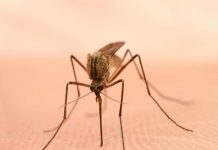
PROVO, Utah, Aug. 3, 2016 (Gephardt Daily) — The public, their pets, and other animals are being warned to stay out of Big East Lake in Payson Canyon due to the discovery of an algal bloom, according to the Utah County Health Department.
The UCHD said in a news release Wednesday it collected samples July 28 to determine the extent and presence of the bloom. Samples showed cell counts significantly over the “dangerous” human health risk threshold of 10 million cells per milliliter according to the World Health Organization’s guidance on harmful algal blooms.
Sampling crews are collecting additional samples and posting warning signs Wednesday.
Crews will conduct preliminary screening tests onsite for cyanotoxins to determine whether
samples need to be submitted to labs for more detailed toxin analysis. Signs are being posted warning people against recreating in the lake because of the presence of harmful algal blooms.
Other area lakes are being sampled and tested as well.
Payson City has stopped drawing water from the lake for its pressurized irrigation system. The pressurized irrigation system is currently using Strawberry Water, Spring Lake water and wells and springs. There should be no concern for residents of Payson City to use their pressurized irrigation system while the health authorities are conducting additional testing on the Big East Lake.
If residents wish to take additional precautions, it is suggested they run their sprinklers
after 10 p.m. and before 6 a.m. to avoid any exposure to the spray. It is also recommended
to restrict children from playing in the sprinklers.
“There is a health risk,” says Ralph Clegg, UCHD executive director. “People should stay out of the water and keep their pets and livestock away from the water.” Additionally, anglers should clean fish well and discard fish guts.
“Conditions are right for algal blooms,” said Ben Holcomb, coordinator of the Division of Water Quality Harmful Algal Bloom Program. “Hot temperatures, lots of sunlight, calm water and elevated levels of nutrients create the bloom. This is not the first algal bloom in the Big East Lake, as it was closed for a month in 2015.”
Although algae are a natural part of many freshwater ecosystems, under the right conditions they can proliferate to create large algal blooms. These blooms can contain harmful cyanobacteria, a type of bacteria, often referred to as blue-green algae, that produces toxins that can pose risks to humans, wildlife, domestic animals and fish.
Symptoms of cyanotoxin poisoning include headache, fever, diarrhea, abdominal pain, nausea and vomiting, and sometimes allergic-like reactions from the skin.
For concerns about possible human exposure, call the Utah Poison Control Center at 800-222-1222, or a physician. For concerns about possible exposure to animals; contact a local
veterinarian.
Updates are available here.
General information about harmful algal blooms is available from Utah Department of Environmental Quality here.
Any concerned residents may call the city offices at 801-465-5200.






